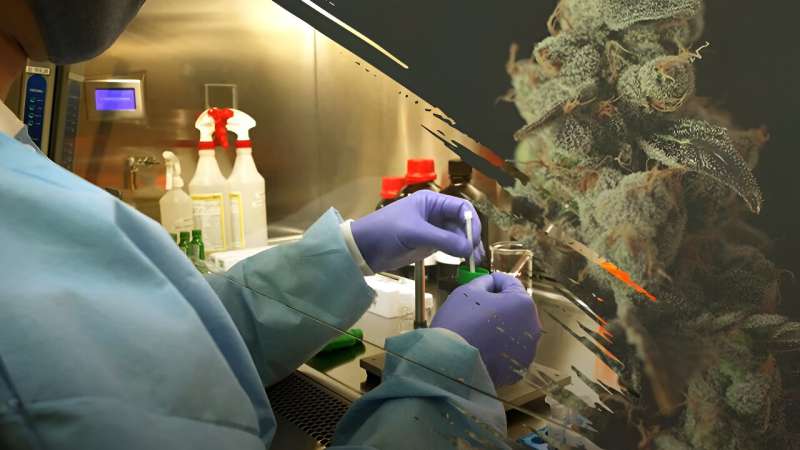This article has been reviewed according to Science X's editorial process and policies. Editors have highlighted the following attributes while ensuring the content's credibility:
fact-checked
peer-reviewed publication
trusted source
proofread
Researchers to test new approach for detecting cannabis in breath

With cannabis now outpacing alcohol as Americans' daily drug of choice, there is a critical need for a scientifically validated breath test to detect the recent use of the substance in drivers.
But developing such a breath test has proved a significant challenge.
Last year, researchers at the National Institute of Standards and Technology (NIST) and the University of Colorado Boulder found that a single breath test may not be reliable in detecting recent cannabis use because cannabis can linger in the body for weeks, making it difficult to distinguish between past and present use.
Now, these researchers are considering a new approach: two breath tests administered within roughly an hour of each other. If their research is successful, it could lead to a roadside test for cannabis use that involves two breath tests given at a specified interval apart.
"This is potentially paradigm-changing," said NIST materials research engineer Kavita Jeerage. "If successful, it could pave the way for on-the-spot detection of recent cannabis use by law enforcement."
Breath tests for alcohol have been around for nearly a century. They detect ethanol, which is exhaled in a gaseous vapor and correlates with the amount of ethanol in the blood.
But tetrahydrocannabinol (THC), the main psychoactive ingredient in cannabis, is present in the breath at a much smaller concentration than ethanol. NIST chemical engineer Tara Lovestead has likened detecting it to "looking for a needle in a haystack."
In addition, the body breaks down and eliminates cannabis much more slowly than ethanol. NIST and University of Colorado researchers have found that the amount of THC in regular cannabis users' breath on days they don't smoke can sometimes be similar to the amount an hour after they've used cannabis. This makes it challenging to distinguish recent and past cannabis consumption among regular users.
Currently, when police pull over a driver they suspect of cannabis impairment, they typically use a battery of roadside tests such as heel-to-toe walking or repeating a sentence correctly. But field sobriety tests, as they are called, can be imprecise, weren't designed for cannabis, and, according to a recent study published in JAMA Psychiatry, can lead to false positives.
"A reliable breath test for cannabis is both a public safety and equity issue," said Lovestead.
Police can also request that the driver pass a blood test, but that may require obtaining a warrant, which usually can't be done on-site and may take hours.
Blood tests may also have a similar problem to breath tests in that cannabis lingers in the bloodstream. Daily cannabis users may maintain elevated levels of THC in their blood for days.
Several breath tests are currently being piloted by law enforcement agencies across the country, but there is still no scientific consensus on whether they work. While NIST doesn't itself develop breathalyzers or breath tests, it does provide guidance and technical expertise on best measurement practices to other government agencies and private industry.
In 2019, researchers at the University of California San Francisco reported that THC levels in the breath of people who smoked cannabis fell by about 95% over three hours after use. According to NIST's Kavita Jeerage, this suggests that sharply falling THC levels in breath may be unique to recent cannabis use. Individuals who have used cannabis days earlier yet still have traces of THC in their breath may not experience either the same amount or the same rate of decline, she said.
In theory, two tests given at different times could determine whether a significant falloff in THC levels was occurring in a driver's breath. It's still not known how far apart the tests would need to be given. Ideally, it would be as short as possible, Jeerage said.
Whether two breath tests spaced 20 or 30 minutes apart would be feasible or practical for drivers and law enforcement officers is an open question and outside the study's scope.
The two-breath test pilot study is being undertaken as part of a $1.5 million interagency agreement between NIST and the National Institute of Justice, part of the U.S. Department of Justice. NIST is carrying out the study in collaboration with the University of Colorado Boulder.
Here's how the study will work:
- Approximately 45 individuals between 25 and 50 years old are being recruited from the Denver and Boulder, Colorado, areas.
- Researchers will assign half the participants a THC-based strain of flower cannabis and half a THC-based cannabis concentrate. They will purchase the drug independently and use it in their homes to ensure compliance with federal laws. Participants can use as little or as much of the cannabis as they wish.
- When they're done, they will immediately come to a mobile pharmacology laboratory operated by the University of Colorado Boulder and parked near their homes. Over two hours, they will complete 10 breath tests at set time intervals apart. Even though participants are taking multiple breath tests, the study's main goal is to find the ideal timing between two breath tests.
- The breath samples will be analyzed for THC, chemical compounds produced when the body breaks down THC (THC metabolites), and selected natural compounds found in cannabis plants (cannabinoids). They will also provide blood samples and complete a questionnaire on cannabis use.
Enrolling participants, carrying out the experiment and analyzing the results are expected to take several years.
"The ultimate goal is to develop a reliable tool that supports fair law enforcement and helps keep our roads safe," said Cinnamon Bidwell, associate professor and co-director of CUChange, a research center at the University of Colorado Boulder that studies health and risk behavior.
More information: Thomas D. Marcotte et al, Evaluation of Field Sobriety Tests for Identifying Drivers Under the Influence of Cannabis, JAMA Psychiatry (2023). DOI: 10.1001/jamapsychiatry.2023.2345



















